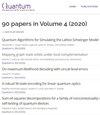违反量子计算机的局部友好性
IF 5.1
2区 物理与天体物理
Q1 PHYSICS, MULTIDISCIPLINARY
引用次数: 0
摘要
局部友好(LF)不等式来源于对现实的看似合理的假设:(i)“观察事件的绝对性”(例如,每个观察到的事件都发生在所有观察者身上)和(ii)“局部代理”(例如,自由选择可以与未来光锥之外的其他事件无关)。扩展维格纳朋友场景(Extended Wigner’s Friend Scenario,简称EWFS)的思想实验表明,教科书上的量子力学违反了这些不平等。因此,这些违反的实验证据将使这两个假设不相容。在[Nature Physics 16, 1199(2020)]中,作者通过实验实现了一个EWFS,使用光子量子比特来扮演每个“朋友”的角色,并测量了LF的违反。人们可能会质疑光子量子比特是否是一个可以算作“观察者”的物理系统,从而质疑实验的结果是否重要。为了度量越来越有意义的违规行为,我们建议使用一种称为“分支因子”的统计度量来量化系统的“观察性”。然后,我们将EWFS编码为量子电路,使得电路中定义友元的组件是增加分支因子的量子系统。我们在量子模拟器和硬件设备上运行该电路,观察随着系统规模的扩大LF违规。由于量子计算机中的误差降低了违规的重要性,因此更好的量子计算机可以产生更好的违规。我们的结果扩展了概念验证实验违规的最新状态,从分支因子0.0扩展到分支因子16.0。这是一个实验项目的初步结果,该项目使用越来越强大的量子处理器和网络,在越来越有意义的分支因子上测量LF违规。我们介绍这个程序作为近期和发展量子技术的基础科学应用。本文章由计算机程序翻译,如有差异,请以英文原文为准。
Towards violations of Local Friendliness with quantum computers
Local Friendliness (LF) inequalities follow from seemingly reasonable assumptions about reality: (i) “absoluteness of observed events'' (e.g., every observed event happens for all observers) and (ii) “local agency'' (e.g., free choices can be made uncorrelated with other events outside their future light cone). Extended Wigner's Friend Scenario (EWFS) thought experiments show that textbook quantum mechanics violates these inequalities. Thus, experimental evidence of these violations would make these two assumptions incompatible. In [Nature Physics 16, 1199 (2020)], the authors experimentally implemented an EWFS, using a photonic qubit to play the role of each of the “friends'' and measured violations of LF. One may question whether a photonic qubit is a physical system that counts as an “observer'' and thereby question whether the experiment's outcome is significant. Intending to measure increasingly meaningful violations, we propose using a statistical measure called the “branch factor'' to quantify the “observerness'' of the system. We then encode the EWFS as a quantum circuit such that the components of the circuit that define the friend are quantum systems of increasing branch factor. We run this circuit on quantum simulators and hardware devices, observing LF violations as the system sizes scale. As errors in quantum computers reduce the significance of the violations, better quantum computers can produce better violations. Our results extend the state of the art in proof-of-concept experimental violations from branch factor 0.0 to branch factor 16.0. This is an initial result in an experimental program for measuring LF violations at increasingly meaningful branch factors using increasingly more powerful quantum processors and networks. We introduce this program as a fundamental science application for near-term and developing quantum technology.
求助全文
通过发布文献求助,成功后即可免费获取论文全文。
去求助
来源期刊

Quantum
Physics and Astronomy-Physics and Astronomy (miscellaneous)
CiteScore
9.20
自引率
10.90%
发文量
241
审稿时长
16 weeks
期刊介绍:
Quantum is an open-access peer-reviewed journal for quantum science and related fields. Quantum is non-profit and community-run: an effort by researchers and for researchers to make science more open and publishing more transparent and efficient.
 求助内容:
求助内容: 应助结果提醒方式:
应助结果提醒方式:


